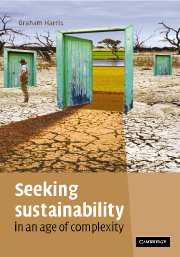Book contents
- Frontmatter
- Contents
- Acknowledgements
- 1 Preamble: the world we are in
- 2 Complexity and complex systems
- 3 New science, new tools, new challenges
- 4 The complexity of ecology
- 5 The generation of complexity
- 6 Micro-interactions and macro-constraints
- 7 A sense of place
- 8 Created landscapes and our changing sense of place
- 9 Catchment form and function
- 10 Catchment loads: ecosystem impacts
- 11 Change detection, monitoring and prediction
- 12 Evidence, uncertainty and risk
- 13 Modified landscapes: biodiversity
- 14 Function in fragmented landscapes
- 15 Environmental flows
- 16 Evidence for global change
- 17 Values and beliefs
- 18 Managing environmental, social and economic systems
- 19 Linking multiple capitals in a changing world
- 20 Community, capacity, collaboration and innovation
- 21 A new environmental paradigm
- 22 Emergent problems and emerging solutions: developing an ‘ecolophysics’?
- 23 Avoiding collapse
- Index
8 - Created landscapes and our changing sense of place
Published online by Cambridge University Press: 21 March 2011
- Frontmatter
- Contents
- Acknowledgements
- 1 Preamble: the world we are in
- 2 Complexity and complex systems
- 3 New science, new tools, new challenges
- 4 The complexity of ecology
- 5 The generation of complexity
- 6 Micro-interactions and macro-constraints
- 7 A sense of place
- 8 Created landscapes and our changing sense of place
- 9 Catchment form and function
- 10 Catchment loads: ecosystem impacts
- 11 Change detection, monitoring and prediction
- 12 Evidence, uncertainty and risk
- 13 Modified landscapes: biodiversity
- 14 Function in fragmented landscapes
- 15 Environmental flows
- 16 Evidence for global change
- 17 Values and beliefs
- 18 Managing environmental, social and economic systems
- 19 Linking multiple capitals in a changing world
- 20 Community, capacity, collaboration and innovation
- 21 A new environmental paradigm
- 22 Emergent problems and emerging solutions: developing an ‘ecolophysics’?
- 23 Avoiding collapse
- Index
Summary
The surprising effects that complex interactions can produce in our created landscapes.
Given the large human population and its global spread, we must accept that the landscapes that most of us grew up in and which we might regard as ‘normal’ – at least those that contribute to our strong sense of place – are largely created by human hands. George Seddon writes:
The sum of the distinctive characters in a given area, whether ‘natural’ or man-made, can be called a ‘landscape’. But although they have a physical substrate, landscapes are also a cultural construct. The ways in which we read them, talk about them, perceive them, work them over, use them, evaluate them functionally, aesthetically, morally: these are all informed by our culture.
Landscapes are not static entities and require constant effort to maintain. It is a sobering thought to realise that many iconic places have been created by people through cultural practices, village and urban development, agriculture and industry. There are few pristine places remaining on this planet. There are a set of semiotics of place – varying with landscape, culture and memory – which condition our language, norms and management actions. The entire English landscape is a created entity, maintained by agriculture: by arable and pastoral farming. There is an underlying set of established metaphors in the English rural and domestic landscape concerning style, design and history and the way these relate the topography to the house and the garden. Don Wayne has called these historical semiotics.
- Type
- Chapter
- Information
- Seeking Sustainability in an Age of Complexity , pp. 101 - 114Publisher: Cambridge University PressPrint publication year: 2007



